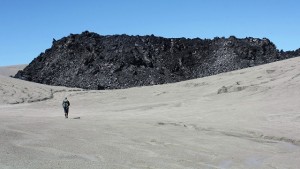
I love it when scientists speak out about their work in their own voices and their own words. A great example is a wonderful set of annotated photos on Flickr that volcanologist Hugh Tuffen put up last month from his recent expedition to Chile's volcano Cordón Caulle. One thing I liked was how he approached and sampled a body of obsidian that was still flowing, several months after its eruption. He could tell the flow was active because its red-hot heart continued to flex its crusty rind, making a memorable noise: "a succession of platy fracturing sounds, as if a bowl of Rice Krispies cereal were made up of thousands of fragile plates that each broke, rather than the usual snap, crackle and pop."
Tuffen regretted not being able to record this. But there are some other recordings of volcano-related sounds out there. Similar to the obsidian noise is the hissing crackle of lava flows moving underwater, their glowing interiors instantly freezing into pillow lava. A Hawaiian tour-diving outfit has a video of such scenes. And volcanologist Boris Behncke, who makes it his business to shoot footage of Sicily's Mount Etna, has captured some good audio of the volcano's roaring lava fountains.
Earthquakes, of course, are nothing but a very loud noise made by the Earth, mostly at very low frequencies. The littlest shakers we get in the Bay Area are more easily appreciated as sound rather than vibration, though. Where I live, events on the Hayward fault arrive from almost directly below with a bang like a nearby truck crash. Seismologist Zhigang Peng, of Georgia Tech University, has a fascinating page with sonifications of the 2011 Tohoku earthquake, made by simply speeding up the earthquake waves into the audible range. They sound a lot like our local jigglers.
If you're ever in a position to watch a flooding river at close range, you might listen for the sound of boulders cracking against each other as they move downstream. One witness told me, "They can ring like bells." In one short video, the rocks sound like big billiard balls in a giant's game.
Up in the mountains where the lakes freeze over, those large sheets of ice produce all sorts of eerie noises as the weather changes. Some liken the sounds to giant springs being struck by hammers, or whining cries, or booming. Geologists classify all these under the name of ice yowling. A YouTube search on "ice sounds" turns up a satisfying variety of recordings.